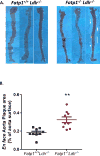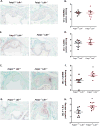Lack of myeloid Fatp1 increases atherosclerotic lesion size in Ldlr-/- mice
- PMID: 29035781
- PMCID: PMC5705203
- DOI: 10.1016/j.atherosclerosis.2017.10.009
Lack of myeloid Fatp1 increases atherosclerotic lesion size in Ldlr-/- mice
Abstract
Background and aims: Altered metabolism is an important regulator of macrophage (MΦ) phenotype, which contributes to inflammatory diseases such as atherosclerosis. Broadly, pro-inflammatory, classically-activated MΦs (CAM) are glycolytic while alternatively-activated MΦs (AAM) oxidize fatty acids, although overlap exists. We previously demonstrated that MΦ fatty acid transport protein 1 (FATP1, Slc27a1) was necessary to maintain the oxidative and anti-inflammatory AAM phenotype in vivo in a model of diet-induced obesity. The aim of this study was to examine how MΦ metabolic reprogramming through FATP1 ablation affects the process of atherogenesis. We hypothesized that FATP1 limits MΦ-mediated inflammation during atherogenesis. Thus, mice lacking MΦ Fatp1 would display elevated formation of atherosclerotic lesions in a mouse model lacking the low-density lipoprotein (LDL) receptor (Ldlr-/-).
Methods: We transplanted bone marrow collected from Fatp1+/+ or Fatp1-/- mice into Ldlr-/- mice and fed chimeric mice a Western diet for 12 weeks. Body weight, blood glucose, and plasma lipids were measured. Aortic sinus and aorta lesions were quantified. Atherosclerotic plaque composition, oxidative stress, and inflammation were analyzed histologically.
Results: Compared to Fatp1+/+Ldlr-/- mice, Fatp1-/-Ldlr-/- mice exhibited significantly larger lesion area and elevated oxidative stress and inflammation in the atherosclerotic plaque. Macrophage and smooth muscle cell content did not differ by Fatp1 genotype. There were no significant systemic alterations in LDL, high-density lipoprotein (HDL), total cholesterol, or triacylglyceride, suggesting that the effect was local to the cells of the vessel microenvironment in a Fatp1-dependent manner.
Conclusions: MΦ Fatp1 limits atherogenesis and may be a viable target to metabolically reprogram MΦs.
Keywords: FATP1; Fatty acid transport protein; LDL receptor; Macrophage; Metabolic reprogram.
Copyright © 2017 Elsevier B.V. All rights reserved.
Conflict of interest statement
The authors declared they do not have anything to disclose regarding conflict of interest with respect to this manuscript.
Figures




Similar articles
-
Deficiency of Dab2 (Disabled Homolog 2) in Myeloid Cells Exacerbates Inflammation in Liver and Atherosclerotic Plaques in LDLR (Low-Density Lipoprotein Receptor)-Null Mice-Brief Report.Arterioscler Thromb Vasc Biol. 2018 May;38(5):1020-1029. doi: 10.1161/ATVBAHA.117.310467. Epub 2018 Mar 29. Arterioscler Thromb Vasc Biol. 2018. PMID: 29599136 Free PMC article.
-
CalDAG-GEFI Deficiency Reduces Atherosclerotic Lesion Development in Mice.Arterioscler Thromb Vasc Biol. 2016 May;36(5):792-9. doi: 10.1161/ATVBAHA.115.306347. Epub 2016 Mar 17. Arterioscler Thromb Vasc Biol. 2016. PMID: 26988592 Free PMC article.
-
Serum Amyloid A Facilitates Early Lesion Development in Ldlr-/- Mice.J Am Heart Assoc. 2015 Jul 17;4(7):e001858. doi: 10.1161/JAHA.115.001858. J Am Heart Assoc. 2015. PMID: 26187995 Free PMC article.
-
Mouse models of atherosclerosis and their suitability for the study of myocardial infarction.Basic Res Cardiol. 2020 Nov 30;115(6):73. doi: 10.1007/s00395-020-00829-5. Basic Res Cardiol. 2020. PMID: 33258000 Free PMC article. Review.
-
Small rodent models of atherosclerosis.Biomed Pharmacother. 2020 Sep;129:110426. doi: 10.1016/j.biopha.2020.110426. Epub 2020 Jun 20. Biomed Pharmacother. 2020. PMID: 32574973 Review.
Cited by
-
Microbiome, bile acids, and obesity: How microbially modified metabolites shape anti-tumor immunity.Immunol Rev. 2020 May;295(1):220-239. doi: 10.1111/imr.12856. Immunol Rev. 2020. PMID: 32320071 Free PMC article. Review.
-
Myeloid-specific fatty acid transport protein 4 deficiency induces a sex-dimorphic susceptibility for nonalcoholic steatohepatitis in mice fed a high-fat, high-cholesterol diet.Am J Physiol Gastrointest Liver Physiol. 2023 May 1;324(5):G389-G403. doi: 10.1152/ajpgi.00181.2022. Epub 2023 Mar 7. Am J Physiol Gastrointest Liver Physiol. 2023. PMID: 36881564 Free PMC article.
-
Metabolite transporters as regulators of macrophage polarization.Naunyn Schmiedebergs Arch Pharmacol. 2022 Jan;395(1):13-25. doi: 10.1007/s00210-021-02173-4. Epub 2021 Dec 1. Naunyn Schmiedebergs Arch Pharmacol. 2022. PMID: 34851450 Review.
-
Friend or Foe? Recent Strategies to Target Myeloid Cells in Cancer.Front Cell Dev Biol. 2020 May 19;8:351. doi: 10.3389/fcell.2020.00351. eCollection 2020. Front Cell Dev Biol. 2020. PMID: 32509781 Free PMC article. Review.
-
The SLC transporter in nutrient and metabolic sensing, regulation, and drug development.J Mol Cell Biol. 2019 Jan 1;11(1):1-13. doi: 10.1093/jmcb/mjy052. J Mol Cell Biol. 2019. PMID: 30239845 Free PMC article.
References
-
- Schaftenaar F, et al. Atherosclerosis: the interplay between lipids and immune cells. Curr Opin Lipidol. 2016;27(3):209–15. - PubMed
MeSH terms
Substances
Grants and funding
LinkOut - more resources
Full Text Sources
Other Literature Sources
Medical
Molecular Biology Databases
Research Materials

